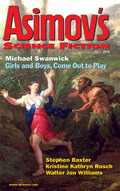
| Editor: | Sheila Williams |
| Issue: | Volume 29, No. 7 |
| ISSN: | 1065-2698 |
| Pages: | 144 |
Overall, this was an average issue of Asimov's. Nothing too extraordinary, nothing too horrible, a little better than the average issue of F&SF. However, Paul Di Filippo writes the "On Books" column in this issue again, and as before his column is excellent. It was a highlight of this issue for me. I'd push for Asimov's to give him the column every week except that they have other excellent reviewers as well.
"The Children of Time" by Stephen Baxter: Baxter is best known for his sweeping hard science fiction stories, featuring timelines covering lengths of time that rival Olaf Stapledon. This is a short story, or rather a linked set of five very short stories, in that mold, telling the lives of four children in the far future of Earth and the human race after ecological and population collapse. It's a daring idea, but the story doesn't go anywhere. The individual children are enjoyable enough to read about, but nothing changes about their worlds over the course of their segment. The final effect is vaguely intellectually interesting for Baxter's extrapolation, but doesn't otherwise capture the imagination. (6)
"Clipper's Last Ride" by Richard Mueller: It takes place on a colony world and involves strange alien creatures, but really, this is a western. It's a western mixed with a love story, featuring a very likable taciturn female hero. The course of the story is fairly predictable from the start, but it has a good bittersweet ending. (7)
"Killing Time" by Kristine Kathryn Rusch: An idea story about technology that would let dying people retreat into a world of pure memory. There's not a lot of plot here, just an exploration of the problems with the concept that touches on attitudes towards caring for eldery people and the tension between making them happy and letting them live the life they can. I agree with the analysis, but they're not particularly ground-breaking thoughts. (6)
"RAW" by Daniel Grotta: Grotta has a good premise in a camera that can see into a diverged alternate reality (yet another use of the multiple worlds theory) and has a great deal of fun working out ways to communicate via only that sort of link. The story starts with some science fiction discovery and exploration of technology and then turns into an X-Files thriller rather suddenly, but that twist fits into the world Grotta has built. Unfortunately, the drawback is that Grotta knows cameras a bit too well and editing not well enough, and as a result the story rambles and goes into far more detail than is actually needed. I liked the idea, but it could have been handled in half the length. (5)
"Waking Chang-Er" by Samantha Ling: This is a continuation and recasting of the ancient Chinese legend of Hou Yi and Chang Er, looking at Chang-Er living on the moon millenia later. The story is told from the perspective of the jade rabbit, who is watching things on Earth and also trying to wake Chang-Er out of her stupor of depression. The story is a touch confusing to someone like myself who isn't familiar with the legend, but the exasperated narrator partly makes up for that. (5)
"The Real Deal" by Peter Friend: This is the story of humans hired to accompany rather strange aliens called Picassos as they search through the remnants of their last galaxy-spanning empire (they've had several) for interesting salvage. It's an amusing light space opera whose twist is built around the question of just why these humans are along in the first place. I expected a bit more punch, but it was enjoyable enough. (6)
"The Compass" by Edd Vick: A rather disturbing story about exiles from a destroyed Earth who are searching for a new planet via means that require a fetus serve as navigator. The questions of sacrifice and duty this raises are predictable and not new themes, but Vick handles them well in a brief and focused story. (6)
"Girls and Boys, Come Out to Play" by Michael Swanwick: I think this is best described as a sword and sorcery story, although the sorcery is really genetic engineering. It functions like sorcery in the story, however, which is about the creation of genetically-engineered gods in a world where satyrs and nymphs live side-by-side with humans and one of the protagonists is an anthropomorphic dog. The story is straightforward without much of a moral or theme, just a diverting adventure. (6)
Reviewed: 2005-11-12